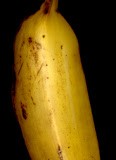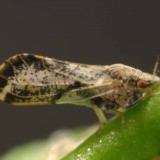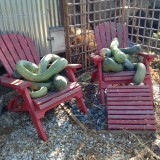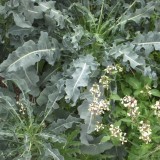A year ago I planted a “Karp’s Sweet Quince” tree from Raintree Nursery and blogged about it, saying that I’d like to hear from fruit expert David Karp for whom the tree is named. Karp called me a few weeks ago to say that he was working on a quince article for the LA Times, “There’s a new taste for quince“. In the article Karp discusses varieties that can be eaten raw as well as how our Southern California climate is an ideal place to grow quince. Karp asked how my tree is doing and I had to say that it’s not doing all that well. In a fit of mad, rare fruit tree planting fever, I put it in a crappy location, in bad soil too close to a large prickly pear cactus that is probably competing with it. We’ll hope it does better in the next season.
Filling in for my lack of backyard quince, Homegrown Neighbor was nice enough to pop by with some she bought local Asian market. The label must have lost something in translation, but refers to a variety called “Pineapple quince”. Karp points out in his article that this is the most prevalent commercial variety. When picked fresh it could conceivably be eaten raw, though the commercial stuff ain’t fresh.
Quince is indeed, as one of Karp’s sources notes, “the poster child of slowness.” I tried to make some jelly with it and greatly underestimated how long it takes to cook. The jelly did not set, so I’ll have to try again. But the fruit did fill the entire house with a heavenly scent. Definitely a fruit worth slowing down for.





Hi. In Portugal (where i’m from), quince is almost an “institution”. For centurys we cooked it into the country’s most popular marmelade: Marmelada.
If you are wondering about the similarity between those two words (marmelade and marmelada), i can explain. In portuguese, quince is called “marmelo” and the result of cooking it with sugar is a very unique sweet called “marmelada”. The sailors in the old world would carry it on their ships because it could be kept for years, and thus spreading the word, nowadays one of several english words derived from portuguese. The tradicional marmelada is not soft or with gelly texture. Its hard and it is cut with a knife. You can make gelly, but using only the fruit’s skin. Loved your book. see you. Nuno Valente
Hmm… maybe we should try making a batch of jam with quince. I wonder what other fruit flavors it would go well with.
I recently purchaced a home with a quince ‘tree’ in it. Its very bushy and appears to be diseased based on the nodules on the branches…
A couple of chef friends of mine were excited that I had all this quince fruit to give to them. They convinced me based on the smell that it may be worth trying to save the ‘tree’. Apparently it is often used with apple. Any advice as to how to go about removing diseased sections or transplanting?
My folks tell me ‘bare root season’ is coming up and this is the best time to do the drastic pruning, planting etc that will be needed in my new excitingly large but sadly neglected backyard.
I bought a Karp’s Sweet Quince from Raintree Nursery and it had grown nicely; however, it is in the process of severe dying back from where I removed blossoms and fruit buds a couple of months ago. I never saw anything like it, the way this tree is failing. I sealed the pruning immediately, when I had done it. I did not think the limbs could support the weight of the fruit yet. In looking at the Raintree Nursery online catelog, it does not seem to list this quince as for sale.
Interesting. Mine has poked along and has grown very slowly. I had to do some radical pruning last year and it’s producing some fruit. Last year the fruit looked sunburned. It’s not been the most healthy or productive tree, that’s for sure. I did get a call a few years ago from David Karp asking me about it. One of these days I’ll get around to doing another post about this tree and I’ll ask Karp to comment.
I planted one a year ago, about fifty miles due north of Austin, Texas. It made it through a hundred days of over one hundred degree temperatures as a bare root transplant, with some judicious hand watering during our drought. This spring it fairly exploded in growth, and is doing quite well, keeps putting out flushes of growth this summer. It never did go fully dormant during winter. It apparently likes the heat.
What variety did you plant? And mine never seems to go fully dormant either. I sometimes pull the leaves off of it in the winter.